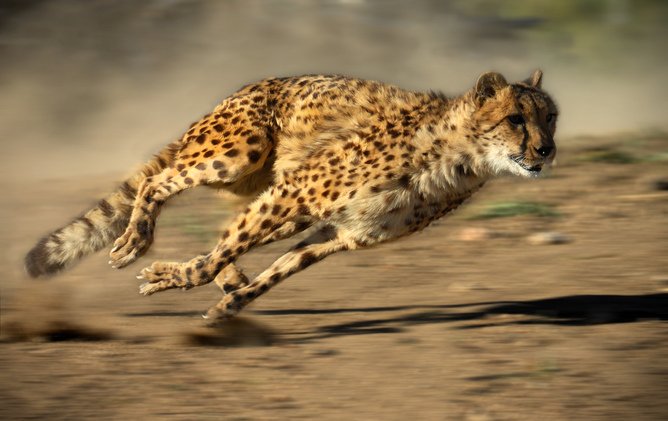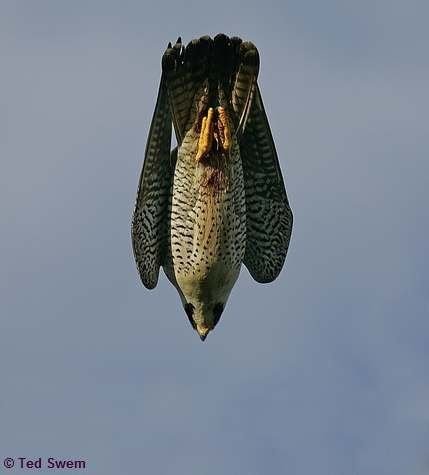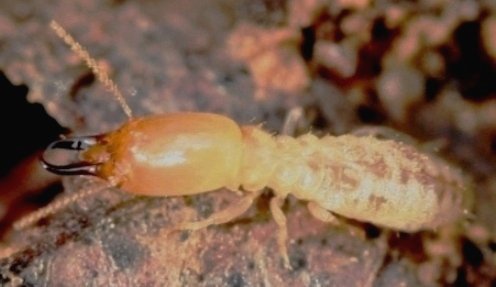Hey guys missed last Saturday as some of you may know we were in New York for a few days, had a great time but I can safely say I’m glad to be back in the drizzly dark dampness of Southern England.
Our flight back was not your ordinary flight back however, our little Norwegian Dreamliner actually set the fastest ever transatlantic flight time of a subsonic passenger aircraft, we flew from New York JFK to London Gatwick in just 5 hours and 13 minutes and reached airspeeds of 787 miles per hour, it was bumpy, fast and probably not worth the amount of money I paid for upgraded seats.
Our Norwegian passenger aircraft reached high speeds, it also took a long time to reach those speeds, of course the speeds were also reached in optimal conditions and were by no means the average.
Anyhow, back to the animals, what is fast in the animal kingdom? Pretty much everyone knows the fastest animal on land is the Cheetah, they can hit speeds of 60 Mph over short distances, though they normally average closer to 30 Mph as their prey do not run in straight lines, more so they are reliant on their agility when hunting… a slightly less impressive figure, though I still wouldn't want to race one.
Let’s explore the true speedsters of the Animal Kingdom.
Honourable mention
The Pistol Shrimp, these little guys aren’t the fastest animals in nature in any aspect of their anatomy, but they are capable of producing an impressively fast phenomenon on a reliable basis.
Pistol Shrimps are equipped with an asymmetrical set of claws, one claw is always significantly larger than the other and doesn't function in the same way as a traditional claw, and for good reason, it’s one of nature’s greatest weapons.
The end of their right claw is capable of retracting to a 90° angle, at this point the claw has been armed, is under tension and is now ready to inflict some damage. Once ready to fire, the Pistol Shrimp releases the tension and the retracted portion of the claw springs forward and collides with the larger section of its claw.
This produces a cavitation bubble that ejects outward from the claw at speeds exceeding 60 Mph, the bubble then collapses and produces a sound that often exceeds 200 decibels, this method of offense is capable of stunning and even killing small organisms, it’s a consistent and reliable form of offense, defence and utility.
I more mentioned this animal as I own one and it’s a fascinating little animal to watch, I regularly hear it excavating its live rock burrow, and have witnessed it send numerous Snails “flying” several inches if they stray to close to its doorway, this post by @herpetologyguy goes in to more detail if you want to know more specific details about them.
The Fastest Moving Animal
To avoid listing a bunch of different animals that are fast in different environments (no one wants to know the fastest organism in a pool full of Custard after all) I’m going to simply refer to the single fastest moving animal of any environment.
It will come as no surprise to anyone that the fastest moving animal on Earth is of course a species of Bird, the fact that their success as a group of animals is underpinned by their ability to thrive in an environment that offers very little friction and has enabled them to develop highly tuned muscular systems that allow them to achieve rapid bursts of speed, Birds of Prey are also able to use gravity in their favour.
The fastest Bird, and the fastest animal on Earth is the Peregrine Falcon, it should be noted that when flying at a stable height the Peregrine Falcon can only reach speeds of 68 mph when relying solely on wing-beats which is slower than other Bird species , whilst this is fast it is no where near the true top speed of the animal.
Peregrine Falcons hunt using a high speed diving technique, by diving at their prey from high altitude they are not only able to catch their prey off-guard, they are also able to reach incredible speeds by working with gravity, the Peregrine Falcon is easily capable of exceeding 200 Mph during a stoop and has been recorded at speeds as fast as 242 Mph all whilst expending very little energy, to put that into perspective it took Engineers until 1923 to invent a vehicle capable of travelling at these speeds through the air and it required a remarkable amount of energy to do so.
The streamlined body of the Peregrine Falcon is as close to aerodynamically perfect as any animal in the Animal Kingdom, they quite literally slice through the air, by sweeping their curved and pointed wings to the rear of their body an efficient aerofoil is created, therefore very little drag is experienced, when partnered with their impressive respiratory system that allows them to regulate air pressure, and maintain breathing during the dive they are capable of being in full control even when top speeds have been achieved.
With their natural design being so incredible it is no surprise that engineers still to this day take inspiration from the aerodynamic capabilities of Birds of prey when designing planes of the future, that will undoubtedly need to be as energy efficient as their natural counterparts.
The Fastest Bodily Function in the Animal Kingdom
So, the Peregrine Falcon is fast, that’s certain, but without a host of external parameters such as Gravity and wind speed they would never be able to reach such speeds, so what’s the fastest function of any animal that doesn’t require external assistance? Aside from myself getting up when Amavi gets home and I haven't tidied anything despite being home all day.
Well we have to think small, really small in fact, you may remember an article I wrote a couple weeks back detailing animal architecture, in that article I mentioned Termites, well they are about to be mentioned again as they do in fact possess the fastest sentient bodily function of any animal on Earth.
Soldier Termites are capable of clamping their Mandibles at speeds of up to 160 Mph, however the function is not technically classified as a bite, to achieve these speeds the Termite presses its elongated mandibles together which in turn creates tension, it then stores energy until it is ready to strike a confrontational opponent.
The Termite approaches its opponent, flips itself on to its back to position on to the underside of its opponent, and then releases the stored energy within the clamped Mandibles, this causes the Mandibles to slide across each other at devastating speeds, upon contact both the Termite and its foe are flung backwards in either direction, the attack is highly efficient and often results in instant death to the opponent via blunt-force trauma.
If the Termite were scaled up to Human size and its mandible weighed roughly 2 kg’s (a low estimate), the force of the blow would equate to an expended force of 5958 Newtons, enough force to inflict severe Trauma to pretty much any animal on the planet... Thankfully Termites are not very large, and we don’t have to worry about them challenging us to the worlds most one-sided Boxing match.
The Fastest Animal Mechanism on Earth
The fastest function of any animal takes place on a cellular level and involves the deployment of Nematocysts, which are secretory Organelles found within Cnidocyte cells.
Nematocysts can be found within various animal species within the Phylum Cnidaria which includes Jellyfish, Hydra and Anemone’s, as Amavi highlighted in a previous post about Clown Fish the Mucus on their skin allows them to withstand the Anemones stinging cells, the quantity and potency of the Nematocysts is however much higher in Jellyfish, a Clown Fish would very much die if exposed to a Jellyfish.
The Nematocyst is essentially a ball like structure with a wound-up hypodermic needle within it, instead of being rigid like your typical hypodermic needle it is instead malleable and does not straighten until fired.
When the jellyfish comes in to contact with an object the Nematocyst is triggered, and it straightens out with the aim of injecting into whatever it touched, once injected the Nematocyst then expends a toxic venom shortly after ejection that normally functions as a Neurotoxin, in the case of the Box Jellyfish its toxin penetrates red blood cells and can induce Heart failure in as few as five minutes in a fully grown adult Human.
The entire process of ejecting the Nematocysts can take Cnidaria species as long as 12 milliseconds in Anemones, or as little as 700 nanoseconds in the case of certain Hydra species, to eject the cells within 700 nanoseconds (billionths of a second) an acceleration of 53.053 million meters/square second takes place, or 5.41 Million g, on average the release of the toxin takes place roughly 20-100 times slower than the ejection of the Nematocyst.
A cool video showing Nematocysts being deployed can be seen below
So, there we have it, some of the fastest animal adaptations in nature, if you know of any more that you believe are faster in each category feel free to comment, there’s an Ocean of information out there and I’d be interested in hearing anything anyone has to add.
I’m going to be starting my own Steemit in the next couple of weeks where I’ll likely divulge in to engineering marvels, feats of ingenuity and technological breakthroughs both past and present, but for this Steemit I will remain strictly natural, see you all soon!
Content Sources
If you enjoyed this article feel free to check out some of my previous works, thanks for reading!








Nice one.
I watched a documentary about those pistol shrimps. They're bad ass and use their claw thingies for hunting unsuspecting prey that come through their territory. Funnies part of it is that they're usually sedentary creatures, only coming to life when they threatened or hunting. The real bad asses.
I also read about one migrating frigate breed of bird that has the highest flight speed, I forget the name.
All the same, I'd rather be a lion or Tiger, the real badasses as far as I'm concerned
Yeah Pistol Shrimps rock, they are ambush predators and are also opportunistic.
I've never observed my one actively hunting, though he does spend literally all day perfecting his burrow, he regularly constructs doorways out of empty shells and even live snails, it's quite entertaining watching him pick up the same snail several times when it's just trying to get away.
Also its relationship with its Goby fish partner is great to watch, they make a great little team.
Yeah, I wouldn't want to be the snail. Haha
Resteemed to over 9400 followers and 100% upvoted. Thank you for using my service!
Send 0.100 Steem or 0.100 Steem Dollar and the URL in the memo to use the bot.
Read here how the bot from Berlin works. News you will find under the hashtag #resteembotnews.
Please help us grow and use our link to trade #IOTA #BTC #ETH and a lot of more at one of the biggest exchanges. https://www.binance.com/?ref=10230705
@resteem.bot
I just stumbled across this series an I like it.
Animals are so amazing. They seem so small (at least most of them, the cheetah isn't that little), yet they are so amazing.
It's so facinating to see which different abillities they developed over time to survive.
We can learn many things by observing the nature and it is always great to discover something new
thanx for the educational post. apart from cheetah I didn't know about other things before reading your article. nice knowledgable post . keep up the good work and enlighten your followers with good work
This looks amaizing.
Cool post Amavi. I watched countless youtube videos of those pistol shrimps in action.
Nice post amavi..Cheetahs are very impressive hunters, they have very good speed and agility. I watched this documentary where a cheetah caught up with a prey that was more than 200 meters away, cheetahs are very amazing animals
Congratulations @amavi! You have completed some achievement on Steemit and have been rewarded with new badge(s) :
Click on any badge to view your own Board of Honor on SteemitBoard.
For more information about SteemitBoard, click here
If you no longer want to receive notifications, reply to this comment with the word
STOPthis pic is SO INSPIRING!!! 🐯
#TmSmile😀 on Twitter promoted your post ~ Thank you for a high quality blog post ~ UpVoted you 😀